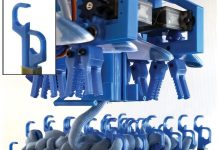
A team of engineers at the Hong Kong University of Science and Technology (HKUST) has achieved a major breakthrough in display technology by developing red quantum rod light-emitting diodes (QR-LEDs) with a record efficiency of 31%, the highest ever reported.
This advance could lead to brighter, more colorful, and energy-efficient displays for future smartphones, televisions, and lighting systems.
The research was published in Advanced Materials.
Light-emitting diodes (LEDs) have been central to modern electronics for decades.
In recent years, scientists have enhanced LED performance by using quantum materials, leading to new types of devices such as quantum dot LEDs (QD-LEDs) and quantum rod LEDs (QR-LEDs).
These technologies can produce extremely vivid colors and higher brightness than conventional LEDs.
However, their efficiency has been limited by how effectively light escapes from the device—a problem known as outcoupling efficiency.
Quantum rods are tiny, rod-shaped nanocrystals that emit light in specific directions. Unlike spherical quantum dots, they can be engineered to guide light more efficiently.
But so far, QR-LEDs have struggled with two major problems: they lose energy after absorbing photons, and the thin films used to make them often have defects that allow electrical current to leak. Both issues reduce their performance and reliability.
To overcome these challenges, the research team led by Professor Abhishek K. Srivastava from HKUST’s Department of Electronic and Computer Engineering refined the way quantum rods are synthesized and structured.
They successfully produced high-quality green and red quantum rods with a remarkable 92% photoluminescence quantum yield—a measure of how efficiently absorbed light is converted into emitted light. The rods were also made with a consistent shape and size, crucial for maintaining stable and uniform light emission.
Next, the researchers used an electrical circuit model to understand how imperfections in quantum rod films cause current leakage, a problem that has often been overlooked in previous research.
This analysis helped them redesign the QR-LED’s internal structure to minimize leakage while improving how electrical charges are injected into the device.
The results were striking. The new red QR-LEDs reached a record external quantum efficiency (EQE) of 31% and a brightness of 110,000 candela per square meter, outperforming all previously reported red QR-LEDs.
When the same design approach was applied to green “dot-in-rod” quantum rods, the devices achieved a 20.2% EQE and an ultra-high luminance of 250,000 cd/m², demonstrating that the technique works across different colors.
“By solving the leakage problem and improving the emissive layer, we’ve shown that quantum rods can outperform quantum dots,” said Prof. Srivastava. “This discovery opens the door to more efficient, high-quality displays and lighting technologies.”
With this achievement, the HKUST team has brought the world one step closer to the next generation of ultra-bright, energy-saving quantum LED displays.



